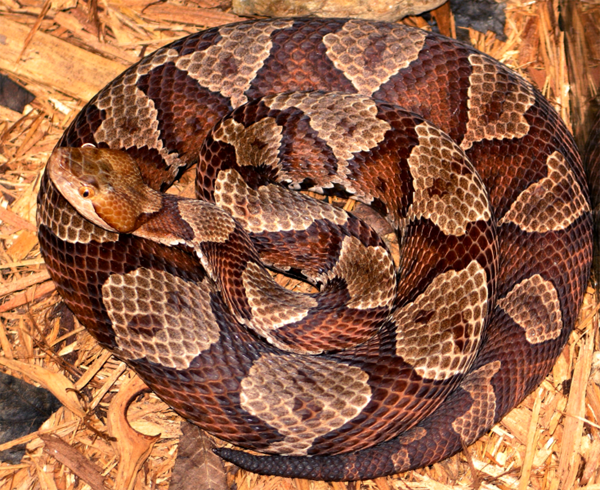Wildlife North America . com North American Animals - mamals, birds, reptiles, insects |
Northern Copperhead (Agkistrodon contortrix mokasen)
Northern Copperhead Photograph by Public Health Image Library (PHIL). License: Public Domain. (view image details)
NORTHERN COPPERHEAD FACTS
DescriptionThe Northern Copperhead has dark chestnut cross bands that are narrower in the center and wider on the sides, giving the bands an hourglass shape. There are often small dark spots between the bands. There are also dark rounded spots at the sides of the belly. The head is a copper-red color. Young snakes are lighter in color with a yellow tail tip and a narrow dark line through the eye. Size length 60cm - 90cm Environment found amongst leaf litter, logs and branches. Food small rodents, ground birds, lizards, large insects, frogs and other small snakes Breeding live bearing with litters from three to ten young. The newborn snakes are left to fend for themselves and have fully developed senses and venom. Range southern Illinois to northern Mississippi, northern Alabama, northern Georgia, and east to the Appalachian Mountains. Notes Bites to humans are very uncommon. Symptoms of bites include intense pain, tingling, throbbing, swelling, and severe nausea. Bite can cause muscle damage. Seek immediate medical attention if bitten. Classification
Relatives in same Genus Common Cantil (A. bilineatus bilineatus) Ornate Cantil (A. bilineatus taylori) Southern Copperhead (A. contortrix contortrix) Broad-banded Copperhead (A. contortrix laticinctus) Osage Copperhead (A. contortrix phaeogaster) Trans-pecos Copperhead (A. contortrix pictigaster) Florida Cottonmouth (A. piscivorus conanti) Western Cottonmouth (A. piscivorus leucostoma) Eastern Cottonmouth (A. piscivorus piscivorus) Home | Mammals | Reptiles | Birds | Insects | Privacy Policy | Disclaimer | Contact Us |